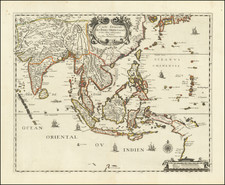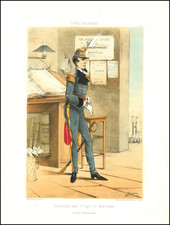This kawaraban shows the portraits of two officers, an American and a Russian, with explanatory text printed around these figures it reflects the interest in these two powerful countries following their arrival in Japan in 1853. It seems likely that the two men depicted are Commodore Matthew C. Perry and Vice-Admiral (later Count) Yevfimy Vasilyevich Putyatin, although neither are named, as both visited Japan during 1853 in an effort to open trade with Japan. The accompanying texts describe the United States and Russia respectively.
The text gives details in turn about the United States and Russia. The section on the United States, titled "United States in North America", explains the growth of nation from having eight states, to the large country it was at the time of publication, of 32 states. It explains that the king of the country does not gain power by the dismissal of their predecessor, but rather that from the country as a whole a brilliant person is selected to become the chief administrator of the country. This person prescribes the laws of the land. This system is known as a republic. The capital is Washington and although originally Europeans established the United States, the behavior of the people is different to those in Europe. It goes further to describe the people as gallant, learned and law abiding. It reports the United States, though a little colder than Japan, is rich. It is located about 5,000-ri away from Japan to the east.
Titled Russia Empire in Europe the second section reports that Russia is the biggest country in the world and that it consists of 51 states. The capital is St Petersburg and the country so large that it is not possible to measure. It reports that the Russian General of all the forces Peter the Great was the most powerful and effective leader of any army in European history. Mention is also made of his fondness for Russian folk arts. The text describes the Russian people as gallant but quite aggressive.
The Perry Expedition was a diplomatic and military undertaking to Japan during its Bakumatsu period. The Expedition involved two separate trips of steamships of the United States Navy, which took place during 1852-1854. The goals of the expedition included exploration, surveying, the establishment of diplomatic relations, and the "opening" of Japan to trade with the United States. The Perry Expedition had a colossal influence on 19th century Japan, leading to interaction with, and influence by, the outside world, the collapse of the Tokugawa shogunate and the Meiji Restoration. In the Western world, the opening of Japan to trade led to a period of Japonisme in decorative and fine arts and culture.
Japanese newspapers began in the 17th century as yomiuri (読売、literally "to read and sell") or kawaraban (瓦版, literally "tile-block printing" referring to the use of clay printing blocks), which were printed handbills sold in major cities to commemorate major social gatherings or events. These sheets were often printed anonymously.
The kawaraban publishers served as a crucial vector for the transmission of information about Commodore Mathew Perry's opening of Japan. During the Edo Period, the arriving European vessels were called kurofune (Black Ships). That time was characterized by great social upheaval, and intense public interest in the agents of the outside world arriving in Japan.
Anna Wada, in "About Kawaraban", Perry in Japan A Visual History, gives background on the kawaraban:
The kawaraban took up a range of topics, including natural disasters, superstitious happenings, murders, and less commonly, political satire. Printers chose topics more to entertain and satisfy the readers’ curiosity than to educate them. Visual components such as illustrations, diagrams, and maps attracted the people to the print and helped them to understand the text, as well as sometimes offering additional information.
Throughout the Edo period the shogunate repeatedly restricted printing for a mass audience, particularly seeking to avoid rumors and political commentary. By the time the Black Ships [i.e., Perry’s fleet] arrived at the end of the Edo period, however, the system of censorship could not keep up with the number of prints in circulation. The increase in publications coincided with the spread of literacy in both urban and rural areas.









![For Governor, Maj. Gen. John W. Geary [Former Mayor of San Francisco / Governor of Kansas Territory and Governor of Pennsylvania]](https://storage.googleapis.com/raremaps/img/small/93592.jpg)
![Carte des parties Nord et Est de L'Asie qui comprend les costes de Russie asiatique le Kamschatka, le Iesso et les isles du Japon…[insets of Alaska, West, AZ and Conibas]](https://storage.googleapis.com/raremaps/img/small/84040.jpg)

![[ Columbus ] Christofel Colonus](https://storage.googleapis.com/raremaps/img/small/105258.jpg)
![Iaponiae Insulae Descriptio Ludoico Teisera auctore [Korea Shown As An Island]](https://storage.googleapis.com/raremaps/img/small/99309.jpg)
